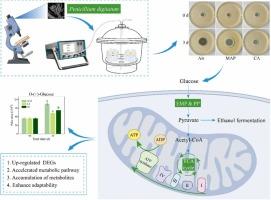Transcriptomics and metabolomics profiling revealed the adaptive mechanism of Penicillium digitatum under modified atmosphere packaging-simulated gas stress
IF 6.8
1区 农林科学
Q1 AGRONOMY
引用次数: 0
Abstract
Modified atmosphere packaging (MAP) is an effective method to preserve fruit and vegetables. However, pathogen inhibition can be challenging due to their adaptive capacity. This study used combined transcriptome and metabolome analyses to elucidate the adaptive mechanism of Penicillium digitatum (P. digitatum) under MAP-simulated gas stress based on its carbohydrates and energy metabolism. The colony diameter of P. digitatum in the MAP treatment was comparable to that in the Air treatment and significantly larger than that in the controlled atmosphere (CA) treatment. Transcriptome and metabolome analyses revealed that MAP treatment facilitated the degradation of 1,3-β glucan, glycogen, and sucrose to glucose, ensuring a sustained glucose supply for the glycolysis (EMP) and pentose phosphate (PP) pathways. Upregulation of related genes in the MAP treatment accelerated the EMP and PP pathways and promoted oxidative glucose degradation. MAP-simulated gas stress augmented P. digitatum’s adaptive response by promoting the EMP, alcoholic fermentation, PP, tricarboxylic acid (TCA) cycle, and oxidative phosphorylation (OXPHOS) pathways and increasing energy production. Based on reverse thinking, this study suggests a potential control strategy for P. digitatum contamination during MAP storage of fruit and vegetables.

转录组学和代谢组学分析揭示了改良气氛包装模拟气体胁迫下数字青霉的适应机制
气调包装(MAP)是保存水果和蔬菜的有效方法。然而,由于病原菌的适应能力,抑制病原菌可能具有挑战性。本研究结合转录组和代谢组分析,基于数字青霉的碳水化合物和能量代谢,阐明了数字青霉在模拟气调包装气体胁迫下的适应机制。在 MAP 处理中,地衣青霉的菌落直径与空气处理中的相当,明显大于可控气氛(CA)处理中的菌落直径。转录组和代谢组分析显示,MAP处理促进了1,3-β葡聚糖、糖原和蔗糖降解为葡萄糖,确保了糖酵解(EMP)和磷酸戊糖(PP)途径的持续葡萄糖供应。MAP 处理中相关基因的上调加速了 EMP 和 PP 途径,并促进了葡萄糖的氧化降解。MAP 模拟的气体胁迫通过促进 EMP、酒精发酵、PP、三羧酸(TCA)循环和氧化磷酸化(OXPHOS)途径以及增加能量生产,增强了 P. digitatum 的适应性反应。基于逆向思维,本研究提出了一种潜在的控制策略,可在水果和蔬菜的 MAP 储藏过程中控制地衣芽孢杆菌污染。
本文章由计算机程序翻译,如有差异,请以英文原文为准。
求助全文
约1分钟内获得全文
求助全文
来源期刊

Postharvest Biology and Technology
农林科学-农艺学
CiteScore
12.00
自引率
11.40%
发文量
309
审稿时长
38 days
期刊介绍:
The journal is devoted exclusively to the publication of original papers, review articles and frontiers articles on biological and technological postharvest research. This includes the areas of postharvest storage, treatments and underpinning mechanisms, quality evaluation, packaging, handling and distribution of fresh horticultural crops including fruit, vegetables, flowers and nuts, but excluding grains, seeds and forages.
Papers reporting novel insights from fundamental and interdisciplinary research will be particularly encouraged. These disciplines include systems biology, bioinformatics, entomology, plant physiology, plant pathology, (bio)chemistry, engineering, modelling, and technologies for nondestructive testing.
Manuscripts on fresh food crops that will be further processed after postharvest storage, or on food processes beyond refrigeration, packaging and minimal processing will not be considered.
 求助内容:
求助内容: 应助结果提醒方式:
应助结果提醒方式:


